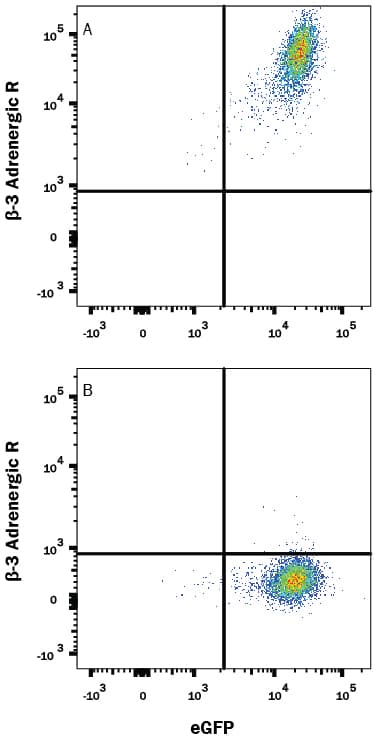



 下载产品说明书
下载产品说明书 下载SDS
下载SDS 用小程序,查商品更便捷
用小程序,查商品更便捷



 收藏
收藏
 对比
对比 咨询
咨询


Met1-Ser408
Accession # P13945


Scientific Data
 View Larger
View LargerDetection of beta ‑3 Adrenergic R/ADRB3 in HEK293 Human Cell Line Transfected with Human beta ‑3 Adrenergic R/ADRB3 and eGFP by Flow Cytometry. HEK293 human embryonic kidney cell line transfected with either (A) human beta -3 Adrenergic R/ADRB3 or (B) irrelevant transfectants and eGFP was stained with Mouse Anti-Human beta -3 Adrenergic R/ADRB3 Monoclonal Antibody (Catalog # MAB9419) followed by Allophycocyanin-conjugated Anti-Mouse IgG Secondary Antibody (Catalog # F0101B). Quadrant markers were set based on control antibody staining (Catalog # MAB0041). View our protocol for Staining Membrane-associated Proteins.
 View Larger
View Largerbeta ‑3 Adrenergic R/ADRB3 in Human Adipocytes. beta -3 Adrenergic R/ADRB3 was detected in immersion fixed human adipocytes using Mouse Anti-Human beta -3 Adrenergic R/ADRB3 Monoclonal Antibody (Catalog # MAB9419) at 15 µg/mL for 3 hours at room temperature. Cells were stained using the NorthernLights™ 557-conjugated Anti-Mouse IgG Secondary Antibody (red; Catalog # NL007) and counterstained with DAPI (blue). Specific staining was localized to cytoplasm. View our protocol for Fluorescent ICC Staining of Cells on Coverslips.
Human beta-3 Adrenergic R/ADRB3 Antibody Summary
Met1-Ser408
Accession # P13945
Applications
Please Note: Optimal dilutions should be determined by each laboratory for each application. General Protocols are available in the Technical Information section on our website.


Background: beta-3 Adrenergic R/ADRB3
ADRB3 belongs to the G protein-coupled receptor 1 family of beta adrenergic receptors. Beta-adrenergic receptors, including ADRB3, mediate the catecholamine-induced activation of adenylate cyclase through the action of G proteins. ADRB3 is involved in the regulation of lipolysis and thermogenesis. A variant of ADRB3 seems to be associated with weight gain (obesity).


Preparation and Storage
- 12 months from date of receipt, -20 to -70 °C as supplied.
- 1 month, 2 to 8 °C under sterile conditions after reconstitution.
- 6 months, -20 to -70 °C under sterile conditions after reconstitution.
参考图片
Detection of beta ‑3 Adrenergic R/ADRB3 in HEK293 Human Cell Line Transfected with Human beta ‑3 Adrenergic R/ADRB3 and eGFP by Flow Cytometry. HEK293 human embryonic kidney cell line transfected with either (A) human beta ‑3 Adrenergic R/ADRB3 or (B) irrelevant transfectants and eGFP was stained with Mouse Anti-Human beta ‑3 Adrenergic R/ADRB3 Monoclonal Antibody (Catalog # MAB9419) followed by Allophycocyanin-conjugated Anti-Mouse IgG Secondary Antibody (Catalog # F0101B). Quadrant markers were set based on control antibody staining (Catalog # MAB0041). View our protocol for Staining Membrane-associated Proteins.
beta ‑3 Adrenergic R/ADRB3 in Human Adipocytes. beta ‑3 Adrenergic R/ADRB3 was detected in immersion fixed human adipocytes using Mouse Anti-Human beta ‑3 Adrenergic R/ADRB3 Monoclonal Antibody (Catalog # MAB9419) at 15 µg/mL for 3 hours at room temperature. Cells were stained using the NorthernLights™ 557-conjugated Anti-Mouse IgG Secondary Antibody (red; Catalog # NL007) and counterstained with DAPI (blue). Specific staining was localized to cytoplasm. View our protocol for Fluorescent ICC Staining of Cells on Coverslips.






 危险品化学品经营许可证(不带存储) 许可证编号:沪(杨)应急管危经许[2022]202944(QY)
危险品化学品经营许可证(不带存储) 许可证编号:沪(杨)应急管危经许[2022]202944(QY)  营业执照(三证合一)
营业执照(三证合一)